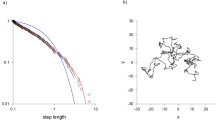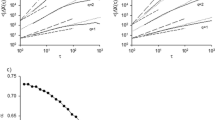Summary
This paper develops a procedure for quantifying movement sequences in terms of move length and turning angle probability distributions. By assuming that movement is a correlated random walk, we derive a formula that relates expected square displacements to the number of consecutive moves. We show this displacement formula can be used to highlight the consequences of different searching behaviors (i.e. different probability distributions of turning angles or move lengths). Observations of Pieris rapae (cabbage white butterfly) flight and Battus philenor (pipe-vine swallowtail) crawling are analyzed as a correlated random walk. The formula that we derive aptly predicts that net displacements of ovipositing cabbage white butterflies. In other circumstances, however, net displacements are not well-described by our correlated random walk formula; in these examples movement must represent a more complicated process than a simple correlated random walk. We suggest that progress might be made by analyzing these more complicated cases in terms of higher order markov processes.
Similar content being viewed by others
References
Broadbent SR, Kendall DG (1953) The random walk of Trichostrongylus retortaeformis. Biometrics 9:460–466
Crumpacker DW, Williams JS (1973) Density, dispersion, and population structure in Drosophila pseudoobscura. Ecol Mon 43:498–538
Jones R (1977) Movement patterns and egg distribution in cabbage butterflies. J Anim Ecol 46:195–212
Jones R, Gilbert N, Guppy M, Neals V (1980) Long-distance movement of Pieris rapae. J Anim Ecol 49:629–642
Kaiser H (1976) Quantitative description and simulation of stochastic behavior dragonflies (Aeschna cyanea, Odonata). Acta Biotheor 25:163–210
Nossal RJ, Weiss GH (1974) A descriptive theory of cell migration on surfaces. J Theor Biol 47:103–113
Rausher M (1979) Coevolution in a simple plant-herbivore system. Dissertation. Cornell University, Ithaca, New York, USA
Root RB, Kareiva PM (1983) The search for resources by cabbage butterflies (Pieris rapae): ecological consequences and adaptive significance of markovian movements in a patchy environment. Ecol Monog (in press)
Saito N (1967) Introduction to Polymer Physics. Syokabo Press, Tokyo
Siniff D, Jessen C (1969) A simulation model of animal movement patterns. Adv Ecol Res 6:185–219
Skellam JG (1951) Random dispersal in theoretical populations. Biometrika 38:196–218
Smith JNM (1974a) The food searching behavior of two European thrushes. I. Description and analysis of search paths. Behaviour 48:276–302
Smith JNM (1974b) The food searching behavior of two European thrushes. II. The adaptiveness of the search patterns. Behaviour 49:1–61
Author information
Authors and Affiliations
Rights and permissions
About this article
Cite this article
Kareiva, P.M., Shigesada, N. Analyzing insect movement as a correlated random walk. Oecologia 56, 234–238 (1983). https://doi.org/10.1007/BF00379695
Received:
Issue Date:
DOI: https://doi.org/10.1007/BF00379695




